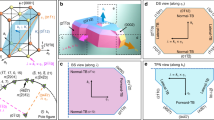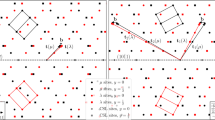Abstract
IN the discussion in NATURE (Jan. 22, p. 120, and Mar. 12, p. 392), Mr. McKeehan has taken exception to statements of Carpenter and Tamura in a paper on the above subject on the grounds that the method of formation of twins depicted by them brings atom centres too close together. Twinning by reflection about a plane is considered, and the discussion hinges on the precise location of this plane with reference to the planes of atoms. Geometrically, a twin crystal of this type consists of two individuals united symmetrically about a plane, which is not one of systematic symmetry but is a possible crystal face (Tutton, “Crystallography and Practical Crystal Measurement,” 2nd ed. vol. 1, p. 500, where it is also stated that the plane of twinning is “usually one with low indices and indeed very often a primary face”). In view of the improbably small distance of approach of atoms required by Carpenter and Tamura's hypotheses, it appeared to be worth while examining the effect of adding to the above geometrical law of twinning the physical conditions (1) that the reflection plane can only be one such that the operation of twinning does not bring atom centres closer to one another than the closest distance of approach of atoms in either component of the twin, and (2) that the components of the twin have in common at least one plane of atoms. Briefly, these conditions imply minimum stress and maximum continuity of structure.
This is a preview of subscription content, access via your institution
Access options
Subscribe to this journal
Receive 51 print issues and online access
$199.00 per year
only $3.90 per issue
Buy this article
- Purchase on Springer Link
- Instant access to full article PDF
Prices may be subject to local taxes which are calculated during checkout
Similar content being viewed by others
Author information
Authors and Affiliations
Rights and permissions
About this article
Cite this article
PRESTON, G. The Formation of Twin Metallic Crystals. Nature 119, 600–601 (1927). https://doi.org/10.1038/119600a0
Issue Date:
DOI: https://doi.org/10.1038/119600a0
This article is cited by
-
Unusual 4H-phase twinned noble metal nanokites
Nature Communications (2019)
-
A review of some elements in the history of grain boundaries, centered on Georges Friedel, the coincident ‘site’ lattice and the twin index
Journal of Materials Science (2011)
-
The Preston of the Guinier-Preston Zones. Guinier
Metallurgical and Materials Transactions B (2010)
-
The Preston of the Guinier-Preston Zones. Guinier
Metallurgical and Materials Transactions A (2010)
-
Measurement of relative interface energies in twin related crystals
JOM (1950)
Comments
By submitting a comment you agree to abide by our Terms and Community Guidelines. If you find something abusive or that does not comply with our terms or guidelines please flag it as inappropriate.



